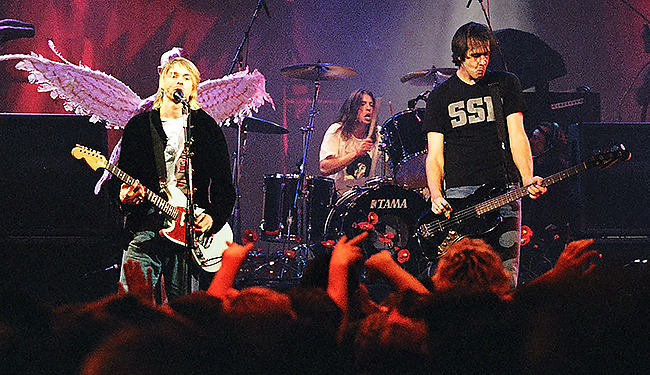
If you listened to rock radio for even five minutes in the 2000s, chances are you were inundated by the menace known as post-grunge. Now, like all musical sub-genres, the term “post-grunge” is a bit nebulous, so, for the sake of this discussion, let’s simply describe it as “bands that sound like Nickelback.” For more than a decade, so called “active rock” radio stations played dozens of bands that had a mind-numbingly similar (and not particularly original) sound.
The aforementioned Nickelback have become the go-to punchline when we talk about this era, as well as when we talk about bad guitar-based music in general. But the truth is, it wasn’t just them. It was also Seether, Theory of a Deadman, Hinder, Saving Abel, Shinedown, Default, Trapt, and countless others. Rock radio became a monolith of a seemingly infinite number of bands, entirely indistinguishable from each other. The end result of this was that most listeners tuned out. What we refer to as “mainstream rock” became entirely irrelevant. Indie bands were capable of topping the charts without any airplay, and at award shows, rock was largely ignored. You’d get the occasional Green Day or Fall Out Boy performance here and there, but for the most part, rock radio’s refusal to change led to it being left behind within the collective musical discussion.
That’s the way it was for years, but at long last, things are looking up. Alt-rock has been gradually making a comeback, and generally speaking, you can comfortably tune in to a rock radio station without hearing an endless string of bands who heard “Far Behind” by Candlebox, and thought Hey, let’s write a bunch of songs that sound like that! Indeed, the alt-rock scene is quite varied today, as in any given listen, you can hear synth-heavy acts like Robert DeLong and MS MR alongside revivalists like Of Monsters and Men and Nathaniel Rateliff & The Night Sweats. The scene is as diverse as it’s been in quite some time. The question is, will anyone really notice?
After reading that last paragraph, you might have asked yourself, “Yeah, but who listens to radio these days, anyway?” Well, I still do, but I will cop to likely being a minority on that front. Spotify and Pandora have more influence than terrestrial radio, which means that while your local rock station has thankfully moved on from playing an endless stream of Breaking Benjamin clones, you probably didn’t notice. This is unfortunate because rock feels more ignored than it’s ever been. Watch any awards show and see how many bands perform. Chances are, it’ll be one or two, and they’ll usually be pop-friendly acts like Imagine Dragons or Maroon 5. Alt-rock stations are giving plenty of bands a chance to be heard, but fewer people than ever are listening. What this means is that the odds of these alt-rock acts breaking out and having a major pop crossover is pretty low. Alt-rock sits in its corner by itself, while the rest of the world pays little attention.
This leads to one logical question: Can alt-rock’s revival have a Nirvana moment? Right now, things feel a lot like they did in the late ’80s; there’s a ton of cool bands getting played on alt-rock and college radio stations, but the rest of the music scene has yet to take notice. It’s a lot like it was 25 years ago; when XTC and Pixies dominated alt-rock and college rock stations, but found little appreciation anywhere else. So, could there be a single that has the sway of “Smells Like Teen Spirit,” and forces everyone else to pay attention?
If so, it can’t be anything lightweight. Sure, Walk the Moon’s “Shut Up and Dance” was an example of an alt-rock band getting mainstream attention, but it was far too non-threatening to really change anything. Nothing against the song, but it’s breezy and poppy, and it kinda sounds like a Maroon 5 tune; the pop world didn’t have to go too far out of its comfort zone to embrace it. Conversely, “Smells Like Teen Spirit” was vastly different from everything else dominating the airwaves at the time. Most top-40 hits were either power ballads or New Jack Swing songs. That’s why a song that was – as Kurt Cobain admitted – a self-conscious attempt to rip off Pixies becoming such a monster success was such a big deal. It served notice that songs that sounded like that could become hits, and as a result, it permanently changed radio programming. Now that radio doesn’t effect tastes the way it used to, it will be intriguing to see if any current artist getting play within the alt-rock world will be able to have a similar impact.
One might argue that this isn’t necessary, that as long as good music is being played, whether or not the stations that play Katy Perry and Taylor Swift embrace it doesn’t really matter. This is an understandable viewpoint, but when I sit through two and a half hours of the VMAs and don’t see a single rock band perform or win an award, it’s a disheartening reminder that rock music is still doing penance for the Nickelback Era, and that in 2015, rock is nothing more than a niche genre. This is simply unfair; rock radio has learned from its dark age, and is more vibrant now than at any point in recent memory. It’s time the rest of the world started noticing that.






